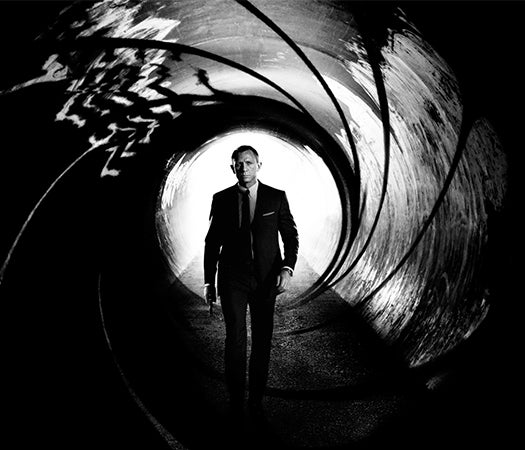When Skyfall hits theaters on Friday November 9, it will be the cinematic franchise’s 50th year in production.
That’s a lot of cultural history right there. Sure, Bond’s world is fictional, but it provides a curious lens into history — especially the colossal threats posed by supervillains whom Bond is, of course, licensed to kill.
Here are five James Bond movies that twist technological threats from the zeitgeist — and from the near future.
See the gallery.
Dr. No
Real-world threat: Wily test missiles Bond version: Nuclear-powered missile jammer Spy fiction has an endless love affair with nuclear weapons technologies, and James Bond’s universe, created in 1952, is no exception. No fewer than six films (more than a quarter of the franchise) rely on nuclear plot devices for Bond to foil and save the world. Arguably one of the best threats is from Dr. No, based on author Ian Fleming’s book published in 1958. Producers released the film in 1962 and took advantage of real-world events to twist the script. Fleming’s Dr. No ran an underground (and very corny) evil lair on a fictitious Caribbean Island. Inside: a nuclear reactor-powered radio beam that could sabotage missiles launched from the nearby (and very real) Turks Island. Because military missile testing at Cape Canaveral wasn’t going well during the movie’s writing — the rockets kept veering off-course — producers leaped at the chance to relocate Dr. No’s lair near U.S. soil, where he sabotaged real-life missile tests from Bond’s fictitious world.
Diamonds Are Forever
Real-world threat: Ronald Reagan’s “Star Wars” Bond version: Diamond-studded satellite laser Diamonds are another stalwart Bond plot device, and in Diamonds Are Forever the gems take center stage. Fleming’s novel has Bond busting an illegal smuggling chain that begins in Sierra Leone and ends in New York City. But Fleming published his novel in 1956, a year before the Soviet Union’s launch of Sputnik — the first artificial satellite in orbit and the starting gun of the race to weaponize space. Inspired by the intensifying Cold War-era conflict, film producers in 1971 conspired to jazz up the book’s plot. Instead of ending the diamond smuggling chain in the Big Apple, the gems went to a remote laboratory outside of Las Vegas. The villain needed them, of all things, to enable a laser satellite that destroys nukes from space. The idea may sound comical now, but in 1983 President Ronald Reagan announced the Strategic Defense Initiative. The press quickly named this program aStar Warsa because one tenet was to use — yes — space-based laser satellites to neutralize nuclear missiles in flight. Who’d have thought? Bond. James Bond.
On Her Majesty’s Secret Service
Real-world threat: Agent Orange Bond version: Women as biological weapons In 1961, John F. Kennedy famously drew his aline in the sanda with communism’s spread and escalated the Vietnam War. The president quickly authorized the use of plant-defoliating chemicals — most famously 12 million gallons of Agent Orange — to denude guerilla hideouts, decimate crops, and force locals to rely on U.S. support. Two years later Fleming published On Her Majesty’s Secret Service. It’s no wonder, then, that Fleming brings biological warfare back to the first world, even if the distribution method was far from flying helicopters. The 1969 movie starring George Lazenby stays true to the novel, which has a villain brainwash beautiful women into a trance-like state, and then distribute livestock- and crop-killing bacterial weapons around the world. Unanticipated parallels abound after the book and movie came out, including Saddam Hussein’s chemical weapons manufacturing program leading up to the Gulf War, anthrax attacks via the U.S. Postal Service, and, most recently, concerns about engineering virulent strains of influenza that afflict only animals to infect humans. Correction: The lead actor of the movie (George Lazenby) was misidentified, and the error has been corrected.
Moonraker
Real-world threat: The space race Bond version: Evil space station Come 1979, Cold War-era nuclear threats that Fleming consistently leaned on in his novels began losing their appeal in movie theaters. Bond franchise producers also had to compete with rich sci-fi fantasies, including a newcomer called Star Wars. Producers met in the middle with Moonraker by taking Fleming’s original, England-based story into orbit — and absurdity. To get there, a neo-Nazi villain named Hugo Drax steals a space shuttle* and even commandeers one of NASA’s goals for its nascent program: build an orbiting space station. But instead of conducting a decades-long microgravity research program, Drax’s orbiting lair is armed with a missile laden with toxins that kill humans but not animals. The idea: wipe Earth clean of humanity and repopulate it with Drax’s amaster race.a Not to spoil the movie for you, but a squadron of lasergun-equipped marines help save the day. * Note: The first space shuttle mission launched three years after Moonraker the movie came out. The first space station piece, meanwhile, didn’t go into orbit until 1998.
Skyfall
Real-world threat: Computer hackers Bond version: Computer hackers… with guns Makers of Skyfall didn’t divulge what inspired their key plot device — the hacking and exposure of information about British agents, leading to their untimely deaths — but PopSci’s best guess is the prolific activity of Anonymous. The ahacktivista group originated in 2003 in an online forum and has gone on to earn Time Magazine’s amost influentiala award. Their prolific acts range from bringing down credit card sites to publishing encrypted emails by oil industry giants. In agreement with the future war intelligence-focused Bond franchise, the U.S. government is always looking to hire hackers as covert intelligence weapons.





